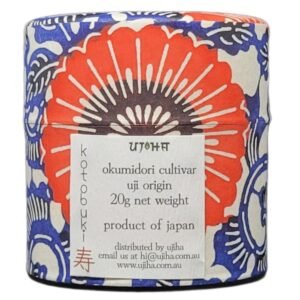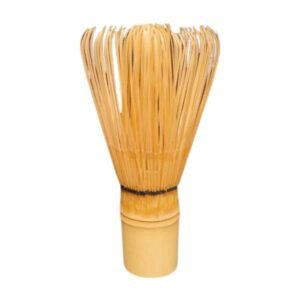Everything you need to know to embark on your matcha journey and achieve mastery. Or, you simply need to know how to drink this stuff the best tasting way possible. Welcome to matcha 101.
Matcha Tools
You don’t need tools to get started. You can achieve ok tasting matcha by using the bottle shake method, more on that later. But to get the best out of your matcha I recommend the following matcha tools:
- Matcha Bowl (Chawan): A wide bowl used for making matcha.
- Bamboo Whisk (Chasen): A special whisk for mixing matcha.
- Matcha Scoop (Chashaku): A bamboo scoop for measuring matcha powder.
- Sifter (Furui): To break up clumps in the matcha powder.
But if you don’t have money for all of that, keep reading…
The Only One Traditional Matcha Tool You’ll Ever Need
Get yourself a bamboo whisk, aka, chasen. While other matcha tools might not significantly impact the taste, the bamboo whisk stands out.
A sifter could be crucial if you’re not a fan of clumpy textures. Sometimes, matcha can form lumps that no amount of enthusiastic whisking will break up.
So, do your taste buds a favor and buy a bamboo whisk and read on…
How To Brew Matcha With A Bamboo Whisk
Great stuff for buying a bamboo whisk, now go froth and brew matcha:
- Heat Water: Boil water, then wait about 5 minutes to let it cool to about 80°C (176°F). We recommend a thermometer to get the perfect temperature every time. Or, the best one is the variable temperature control kettles.
- Sift Matcha: Use the sifter to put 1-2 scoops (about 1g – 1.5g) of matcha into the bowl.
- Add Water: Pour 80ml of water into the bowl.
- Whisk: Use the bamboo whisk to mix the matcha and water. Move it quickly back and forth in a “W” shape until frothy.
- Add More Water: If you like, add more hot water or milk.
This water to matcha powder ratio is for beginner tea drinkers. We think it is the best ratio to enjoy the pure taste of matcha for someone new to tea.
For a more awesome tasting experience, we recommend either increasing the matcha powder or decreasing the amount of water.
You can stick to 1 gram of matcha powder and decrease the water weight to 60 ml. Or vice versa, increase the matcha powder to 2g but stick to 80 ml.
Honestly, you can play around with these numbers. Everyone’s palate is different after all.
How To Use A Bamboo Whisk (Chasen)
Thinking of how to use a bamboo whisk? Here’s how…
Koicha or Thick Tea
The above tea we just prepared is called usucha or thin tea. When you’re ready for a boosted matcha taste experience, try koicha or thick tea.
I must warn you though, using culinary grade and lower quality matcha to make koicha will feel like being punched in the face by Mike Tyson in his prime.
Try Kotobuki. Our supreme matcha offering.
-
 Ujiha Kotobuki Supreme Organic Ceremonial Grade MatchaPrice range: $39.99 through $54.99
Ujiha Kotobuki Supreme Organic Ceremonial Grade MatchaPrice range: $39.99 through $54.99
Preparing koicha is easy, just do the following:
- Heat water to 80°C (176°F).
- Sift 4 grams of matcha powder to the chawan (matcha bowl).
- Pour 30 ml or 40 ml of hot water.
- Use the chasen (bamboo whisk) to slowly mix the matcha powder and water to a paste-like consistency. The paste should be thick and glides easily.
- Enjoy the super-focused, mental clarity, this powered up matcha bring.
Brewing Methods Without Matcha Tools
You don’t want to or can’t buy a chasen? We understand. Heck, we used a spoon to whisk the matcha for a while, then the fork, a hand frother, and a protein shaker. Eventually tried the bamboo whisk and let me tell you, matcha tastes best when whisked with a bamboo whisk. But hey, we can’t force you. The following are alternative methods to make matcha without tools:
- Jar/Bottle Shake: Put matcha and a little warm water in a jar. Close the lid tightly. Shake it well until it’s mixed and frothy. Then, add more water or milk.
- Milk Frother: You can use a regular milk frother to mix the matcha. It might not be as frothy vs using a bamboo whisk, but it still works.
- Wire Metal Whisk: This is your regular whisk found in most kitchens. It doesn’t create as much foam and also noisy as hell. One thing for sure is that your roomies will know you’re preparing matcha.
- Spoon/Fork: Our least favorite method to whisk matcha that we definitely do not recommend is using a spoon or fork. Add matcha and water to a cup. Use spoon or fork to stir. Enjoy the lumpy matcha.
Knowing the best way to brew matcha is not enough to keep having that perfect matcha, you also need to learn how to store it properly to keep it fresh and at its best longer.
Storing Matcha
Properly storing matcha is the best way to preserve its nutrients and flavor. Matcha in a pouch-type packaging is not ideal storage for matcha after the seal is broken. The tin can adequately store matcha.
The following are our recommendation to store matcha:
- Airtight Container: Use an airtight container to keep it fresh. Using a tea caddy or a mason jar with a rubber seal on the lid to keep the air out is the best way to store matcha.
- Keep it Cool: Store matcha in a cool, dark place.
- Avoid Smell: Matcha can attract other smells and may stick to it. So, if you don’t want your matcha to taste like last night’s green curry keep it airtight.
- Avoid Light and Air: Light and air can make matcha lose its flavor.
Should You Store Matcha in the Fridge or Freezer?
While it might seem logical to refrigerate matcha powder to keep it fresh, we do not recommend storing opened matcha in the fridge. Matcha is highly sensitive to moisture and odors, both of which are common in refrigerators. Improper fridge storage can quickly ruin its delicate flavor and vibrant color.
Instead, here’s the best approach:
- Buy smaller portions: Matcha is best enjoyed fresh. Purchase only what you can finish within 1 to 2 months of opening to ensure peak quality.
- Avoid large bags: If buying in bulk, opt for multiple small, sealed bags rather than one large container. This reduces exposure to air and preserves freshness.
- Fridge storage is only for unopened matcha: If you must store extra matcha, keep the unopened, sealed bags in the fridge for longer-term storage. Ensure they’re in airtight, odor-proof packaging.
- Warm to room temperature before opening: When ready to use refrigerated matcha, let the unopened bag return to room temperature. This prevents condensation, which can ruin the powder.
Why Refrigerating Opened Matcha Isn’t Practical
While refrigeration can extend the shelf life of unopened matcha, it’s not advisable for opened containers due to the risk of condensation. When cold matcha is exposed to warmer air, moisture can form inside the container, leading to clumping and degradation of flavor and color. To prevent this, matcha must be brought to room temperature before opening, a process that can take several hours. This waiting period is often inconvenient for daily users.
Key Takeaway:
For the freshest matcha experience, buy only what you’ll use in a month. Opened matcha should be stored in a cool, dark cabinet, never the fridge. Only unopened, sealed packs can benefit from refrigeration.
Conclusion
Matcha is more than just a trendy green drink — it’s a mindful ritual, a powerhouse of antioxidants, and a moment of calm in a busy day. Whether you’re here to sip it for focus, health, or simply because it tastes amazing, the key to a great matcha experience lies in quality tools, proper brewing, and mindful storage.
- Start simple: A bamboo whisk is the one essential tool you need to unlock matcha’s best flavor and texture.
- Brew it right: Focus on water temperature, sift your powder, and whisk like you mean it.
- Store it smart: Matcha is fragile, protect it from air, light, heat, and moisture. Avoid refrigerating opened matcha. Instead, buy in small portions and only refrigerate unopened, sealed packs if necessary.
Remember: freshness is king. Buy what you’ll finish in a month, and your matcha will always taste its best.
Now that you know how to brew, whisk, and store it properly, you’re ready to level up from matcha beginner to true matcha lover.



